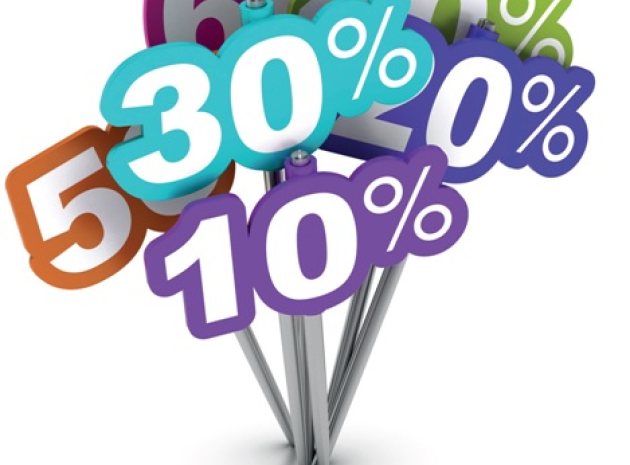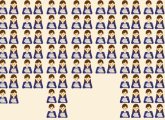Is 50% off a better deal than 50% extra free? Using number puzzles can help students get to grips with the issues surrounding percentage change, says Colin Foster…
Why Teach This?
Solving maths puzzles can be a good way to get lots of practice with a mathematical technique while something a bit more thought-provoking is going on. Percentages crop up all over the place in daily life, and many people misinterpret and misunderstand them. This lesson helps to clarify students’ thinking about percentage change.
As soon as you enter a shopping precinct or high street anywhere, you will see signs advertising “50% off” or “50% extra free”. Unless students understand what these percentage changes mean, they will be vulnerable to being misled and exploited. Is “50% extra free” better or worse than “50% off”? Perhaps it depends on how much of the item you want and how much money you have available at the time.
In this lesson, students explore what happens to a certain amount of money when it undergoes a particular percentage increase or decrease. They will discover that a 50% increase followed by a 40% increase is not a 90% increase, and a 50% increase followed by a 50% decrease does not get you back to where you started! In the main part of the lesson, KS3 students will work on a puzzle that will involve them in a lot of intelligent trial and error, generating plenty of practice at percentage increases and decreases but also helping them to understand more deeply how these work. By the end of the lesson they should be able to handle percentage calculations confidently, have a sense of the misconceptions to avoid, and have developed a stronger understanding about percentage change.
Starter activity: Giving 110%
Q. Look at these two statements. Which is the bigger increase and why?
A 40% increase followed by a 50% increase.”
“Double your money.”
Most students will probably think that “Double your money” is better. They are likely to assume that a 40% increase followed by a 50% increase is a 90% increase, which is less than doubling what you start with. But this is wrong. If they think this, don’t tell them they are wrong – instead encourage them to try it out with some numbers.
Q. What happens if you start with £100?
A 40% increase makes £140, but then a 50% increase on top of that means adding £70, not £50, because the 50% refers to 50% of the £140, not 50% of the original £100. So the final amount is £210. In general, a 40% increase followed by a 50% increase is a 110% increase, whereas doubling is just a 100% increase.
Students might think that percentages greater than 100 are impossible, but this is not the case. A percentage increase of more than 100% simply means that the final amount is more than twice the starting amount.
Q. What happens if you switch around the order, so you have a 50% increase followed by a 40% increase? What happens with other pairs of percentage increases?
A Students may be surprised that the order makes no difference. It is still a 110% increase. Increasing by 40% is equivalent to multiplying by 1.4, and increasing by 50% is equivalent to multiplying by 1.5, so the order doesn’t matter, since 1.4 x 1.5 = 1.5 x 1.4. Both are equal to 2.1, which is a 110% increase. In general, an a% increase followed by a b% increase is equivalent to an (a + b + ab/100)% increase.
Q. What happens with decreases? What if you have a 40% decrease followed by a 50% decrease? What is that the same as? What happens with other pairs of percentage decreases?
A 40% decrease followed by a 50% decrease is equivalent to a 70% decrease. In general, an a% decrease followed by a b% decrease is equivalent to an (a + b – ab/100)% decrease. Students will probably not approach this algebraically but instead will explore what happens with some different starting numbers.
Main activity
- Write these four statements on the board:
- £ ____ increased by ____ % = £ ____
- £ ____ increased by ____ % = £ ____
- £ ____ decreased by ____ % = £ ____
- £ ____ decreased by ____ % = £ ____
Q. Can you suggest some possible numbers to go in the gaps here?
A. Students should be able to choose values for the two gaps on the left-hand side of each equation and then calculate the answer on the right-hand side. If this is too easy, you could challenge students to make all of their numbers whole numbers, or to make all of their numbers multiples of 10, or to make all of their numbers different, or to do it without a calculator.
Q. Now I have a puzzle for you. I want you to find where these 12 numbers can go in the 12 spaces. You have to use each number once.
10, 20, 25, 35, 40, 50, 60, 70, 75, 80, 90, 100
A task sheet for students to write on is available at www.foster77.co.uk/Percentage%20Change%20TASK%20SHEET.pdf
There are many possible ways of fitting the numbers into the spaces if repetition is allowed.
- Some examples are:
- £20 increased by 25% = £25 £40 decreased by 50% = £20
- £25 increased by 40% = £35 £60 decreased by 25% = £45
- £40 increased by 50% = £60 £60 decreased by 50% = £30
- £40 increased by 75% = £70 £70 decreased by 50% = £35
- £50 increased by 20% = £60 £80 decreased by 50% = £40
- £50 increased by 80% = £90 £80 decreased by 75% = £20
- £60 increased by 25% = £75 £100 decreased by 75% = £25
However, there are only three ways to fit in all 12 numbers without any repetitions. (Of course, the two “increase” lines and the two “decrease” lines could be swapped in each solution.)
- One is:
- £20 increased by 75% = £35
- £50 increased by 40% = £70
- £80 decreased by 25% = £60
- £100 decreased by 10% = £90
Another is obtained by just swapping the 10 and the 90 in the final line. (You could ask students why the second and third numbers in the other lines can’t be similarly swapped.)
- And the third is:
- £40 increased by 100% = £80
- £75 increased by 20% = £90
- £25 decreased by 60% = £10
- £70 decreased by 50% = £35
Students will need some time to experiment in order to obtain these, and lots of useful practice and thinking will take place during the process. If anyone succeeds in finding all three solutions, you could ask them to make up their own set of 12 numbers that will work and see if someone else can solve it. Can they make it have just one solution?
Summary
You could conclude the lesson with a plenary in which the students talk about what they have learned. Has anything surprised them? Did they find any quick ways of finding percentage increases or decreases? Did they become better at estimating the answers without doing the calculations?
Students may have noticed that, for instance, although £50 increased by 40% is £70, it is not the case that you can simply reverse this and say that £70 decreased by 40% is £50. This is one of the features that makes the puzzle hard! In fact, £70 decreased by 40% is £42, which is less than £50, because the 40% decrease is 40% of £70, which is a larger amount than 40% of £50. (In fact, because £70 is £20 more than £50, the answer is 40% of £20 = £8 smaller.) It can be challenging for KS3 students to try to explain these differences but a good opportunity for them to try to make sense of how percentage change works and develop precise mathematical communication.
Additional resources
A nice percentage increase problem is available at nrich.maths.org/515 and another, for those who like code puzzles, is available at nrich.maths.org/4799.
Stretch them further
Students could explore how long it would take to “double your money” in a bank account with a fixed rate of interest. For example, if the interest rate is 10% per year, how many years will it take before you double your money? (A spreadsheet would be useful.) It will take somewhere between 7 and 8 years, because 1.17 < 2 < 1.18. How does this answer depend on the interest rate? In finance, there is a rough rule, called the “rule of 70” (or a number close to 70), which gives an approximate answer to this problem. You just calculate 70 divided by the interest rate to obtain the approximate number of years needed to double your money. In this case 70/10 = 7, which is about right. When there is inflation, you can use this rule to work out how long it will take for the money’s buying power to halve by calculating 70 divided by the inflation rate.About our expert
Colin Foster is an Assistant Professor in mathematics education in the School of Education at the University of Nottingham. He has written many books and articles for mathematics teachers (see www.foster77.co.uk). Acknowledgement Colin would like to thank Tom Spillane for establishing that there are exactly three solutions to the puzzle.For a huge selection of free maths lesson plans for KS3 and KS4 click here.










